How To Read Car Tyre Markings? All You Need To Know
Reading the assortment of characters and numbers on the sidewall of a tyre may confuse you more than tell you more about the tyre. Nonetheless, the marks on the tyres adhere to an international standard and provide information critical to evaluating products and making safety judgements. Once you decipher the code, you'll have practically all the information you need about your car tyres.
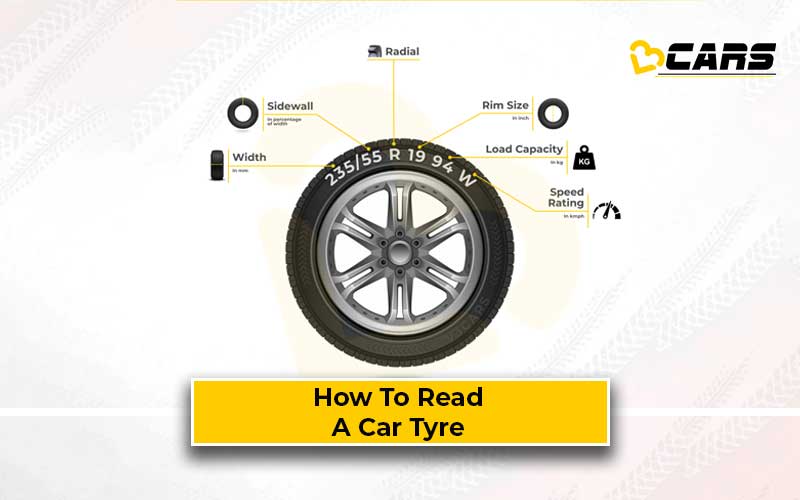
In this article, we will explain the meaning of all the markings on a car tyre so that you can decipher it by yourself. For better understanding, you can refer to the images in the article to understand the format of information on the tyre sidewall.
How To Read Car Tyre Code?
Apart from the brand and name of your car’s tyre, the sidewall of a tyre also shows you 6 other major pieces of information. These include the width and aspect ratio of the tyre, its internal construction and diameter, its load index and speed rating, and finally, its manufacturing date.
The image below depicts an example, which we then dissect point by point.
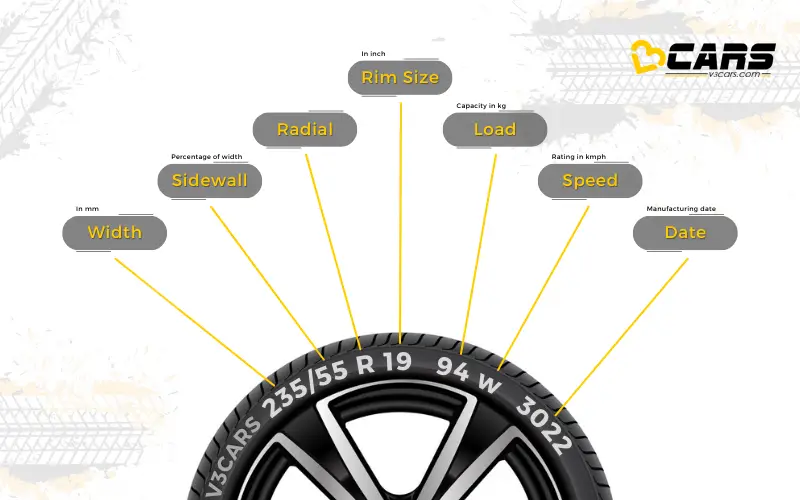
1. Tyre Width
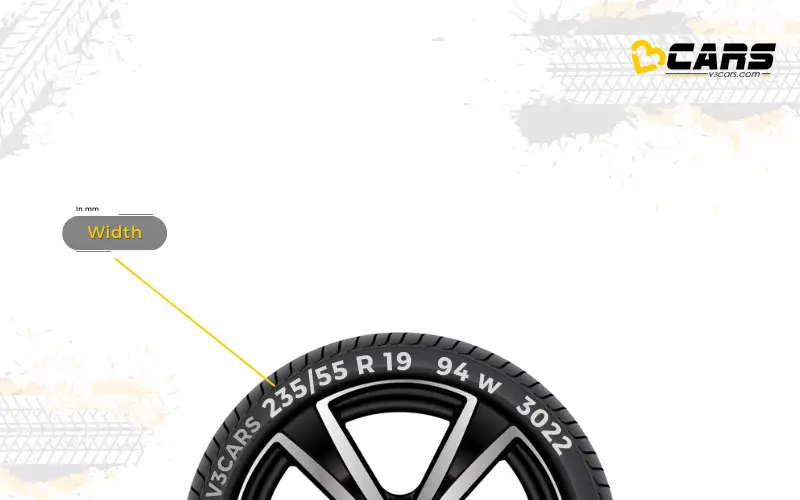
The first number in the image above, which is 235, indicates the width of the tyre in mm. In this case, the part of the tyre in contact with the ground is 235mm wide.
2. Aspect Ratio
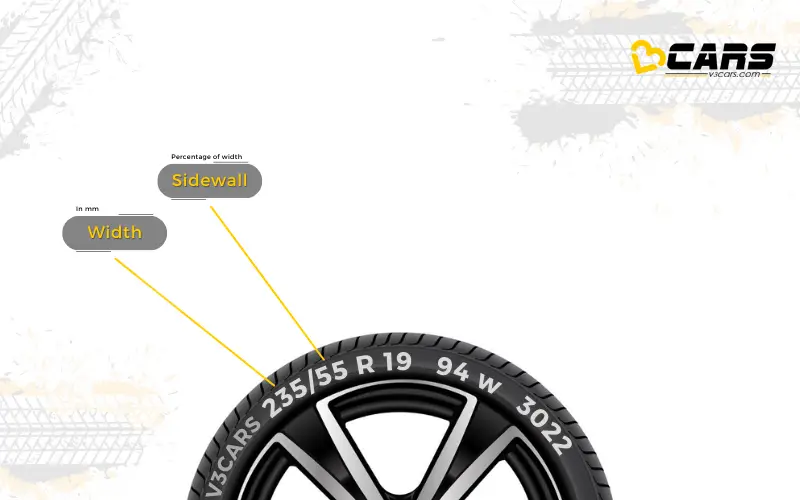
The number which follows 235 followed by the slash indicates the aspect ratio of the tyre. The aspect ratio is the measure of the tyre between the rim and the surface. The number written is the percentage of the width of the tyre. In this case, the tyre’s sidewall is 55, which means 60% of 235mm. A higher sidewall usually delivers better comfort. In off-road conditions, a taller sidewall lets you deflate the tyres more than usual to improve the contact patch and grip. On the other hand, a lower sidewall means a stiffer ride but better handling.
Note: Check out the list of Electric Cars in India
3. Tyre Construction
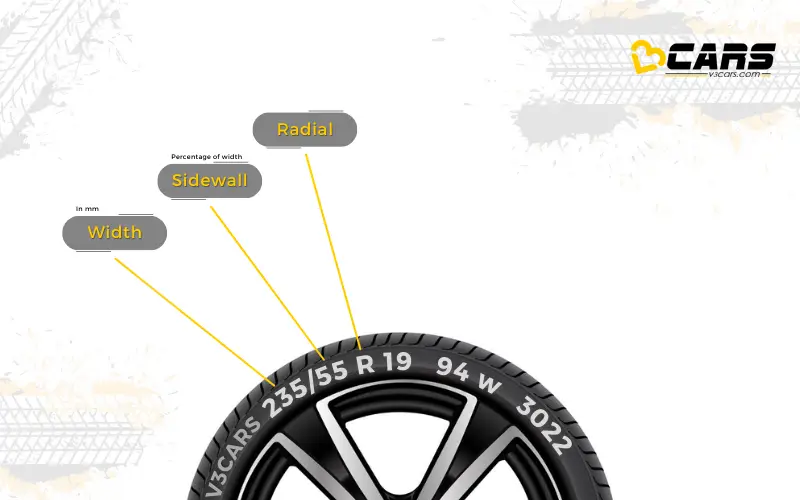
The letter that follows the first 2 numbers indicates tyre construction. All new cars come with tyres with radial construction, which is denoted by the letter R. Older cars had tyres with the letters B, D or no character, which indicates bias ply or diagonal.
4. Rim Diameter
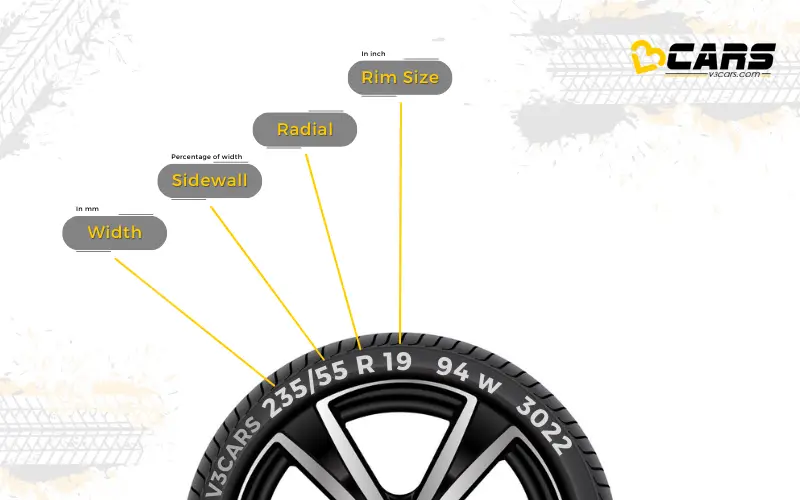
After the tyre body construction letter comes a 2-digit number that indicates the diameter of the rims on which the tyre is intended to be placed. Inches are used to express this measurement. The tyre in this example is suitable for 19-inch rims.
Note: Check your car’s fuel cost with Fuel Cost Calculator India
5. Load Index or Load Capacity
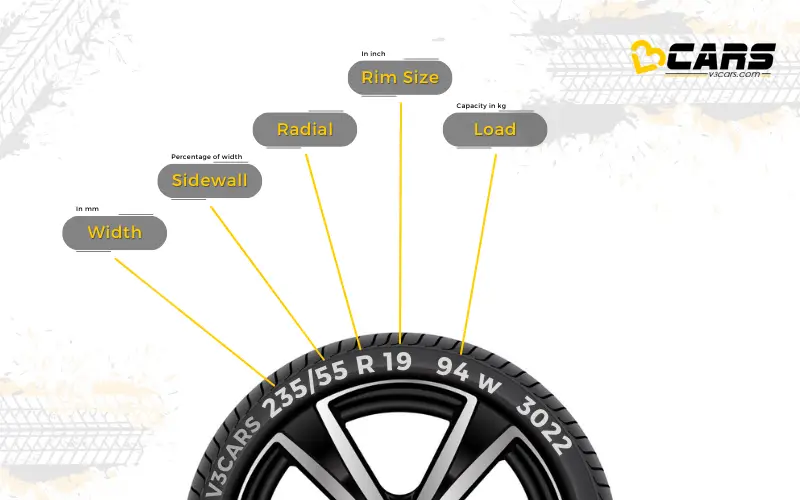
The next number is the tyre’s rating for its load capacity. This number ranges between 50 and 122 depending on the type of vehicle. In this case, the number 94 denotes a loading capacity of 670kg per tyre. You can refer to the table below to know how much weight a tyre can carry.
|
|
|||||
|
|
|
|
|
|
|
|
|
|
|
|
|
|
|
|
|
|
|
|
|
|
|
|
|
|
|
|
|
|
|
|
|
|
|
|
|
|
|
|
|
|
|
|
|
|
|
|
|
|
|
|
|
|
|
|
|
|
|
|
|
|
|
|
|
|
|
|
|
|
|
|
|
|
|
|
|
|
|
|
|
|
|
|
|
|
|
|
|
|
|
|
|
|
|
|
|
|
|
|
|
|
|
|
|
|
|
|
|
|
|
|
|
|
|
|
|
|
|
|
|
|
|
|
|
|
|
|
|
|
|
|
|
|
|
|
|
|
|
|
|
|
|
|
|
|
|
|
|
|
|
|
|
|
|
|
|
|
|
|
|
|
|
|
|
|
|
|
|
|
|
|
|
|
|
|
|
|
|
|
|
|
|
|
|
|
|
|
|
6. Speed Index
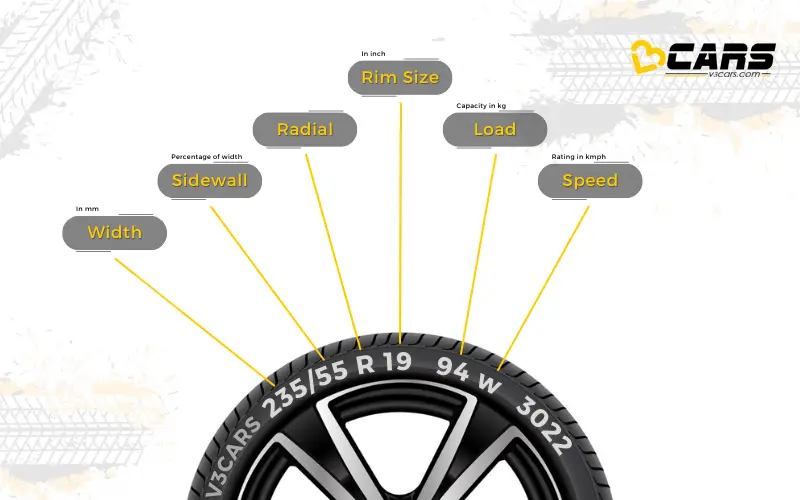
The speed rating of the tyre is also indicated indirectly, this time via a letter code. This letter can be used to determine the tyre's maximum safe speed with a fully loaded vehicle (according to its load index rating). The letter W in this example indicates that the tyre is rated for sustained speeds of up to 270kmph.
Also Read - Tyre Pressure Monitoring System (TPMS) - Feature Explained
|
|
|
|
|
|
|
|
|
|
|
|
|
|
|
|
|
|
|
|
|
|
|
|
|
|
|
|
|
|
|
|
|
|
|
|
|
|
|
|
|
|
|
|
|
|
|
|
|
|
|
|
|
|
|
|
|
|
|
|
|
|
|
|
|
|
|
|
|
|
|
|
|
|
|
7. Manufacturing Date
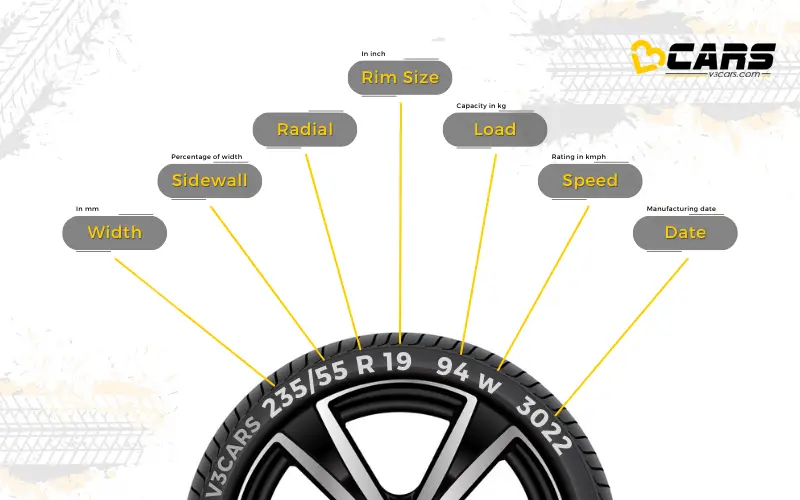
Finding a car tyre’s manufacturing date is quite straightforward. Before purchasing the tyre, locate the 4-digit number on the sidewall. For example, in this case, the marking is 3022, which means this tyre was made in the last week of July 2022.
Also Read: 2023 Hyundai Verna Sedan Bookings Open — 4 Variants And 2 Engine Options
People Also Ask (FAQs)
Q. What do the markings on tyres mean?
The markings on a tyre provide important information about the tyre's specifications and capabilities. Here are some common markings and what they mean:
Tyre Size: The tyre size is typically indicated by a series of numbers and letters, such as 215/65 R16. This information specifies the tyre's width, aspect ratio, and diameter.
Load Index: The load index represents the maximum weight a tyre can support when properly inflated. It is indicated by a numerical value, such as 94, which corresponds to a specific weight in pounds or kilograms.
Speed Rating: The speed rating indicates the maximum speed at which the tyre can safely operate. It is denoted by a letter, such as H, V, or W. Each letter corresponds to a specific maximum speed limit.
Treadwear Rating: The treadwear rating provides an estimate of the tyre's expected lifespan.
Q. How do you read tyre markings on a car?
Reading the tyre markings on a car can be done by understanding the information provided on the sidewall of the tyre. Here's a breakdown of how to read common tyre markings:
Tyre Size: The tyre size is typically represented as a series of numbers and letters, such as P 215/65 R16. Here's what each component signifies:
- "P" or "LT": Indicates the tyre's type. "P" stands for passenger car, while "LT" represents light truck.
- "215": Represents the tyre's width in millimeters. It measures the distance from sidewall to sidewall when the tyre is properly inflated and not loaded.
- "65": Represents the tyre's aspect ratio, which is the ratio of the tyre's height to its width. In this case, the tyre's height is 65% of its width.
- "R": Indicates the tyre's construction type, where "R" stands for radial.
- "16": Represents the diameter of the wheel in inches that the tyre is designed to fit.
Load Index and Speed Rating: These markings indicate the tyre's maximum load capacity and speed rating.
- Load Index: It is represented by a number, such as 94, which corresponds to a specific weight carrying capacity. You can refer to load index charts to determine the weight capacity in pounds or kilograms.
- Speed Rating: It is denoted by a letter, such as H, V, or W, which represents the maximum speed that the tyre is designed to handle.
Treadwear, Traction, and Temperature Ratings: These markings provide information about the tyre's performance and durability.
- Treadwear Rating: It is indicated by a number, such as 400, which represents the tyre's relative durability compared to a standard reference tyre. Higher numbers indicate a longer tread life.
- Traction Rating: It indicates the tyre's ability to grip the road under wet conditions. It is graded using letters, such as AA, A, B, or C, where AA represents the highest traction performance.
- Temperature Rating: It represents the tyre's ability to dissipate heat. It is graded using letters, such as A, B, or C, where A represents the highest temperature resistance.
Q. Why are tyre markings important?
Tyre markings are important because they provide crucial information about the tyre's specifications and capabilities. Here are a few reasons why tyre markings are significant:
Size and Compatibility: Tyre markings indicate the tyre's size, including width, aspect ratio, and diameter. This information is essential to ensure that the tyre is compatible with the vehicle and fits properly on the wheel. Using the correct tyre size is crucial for maintaining vehicle performance, handling, and safety.
Load Capacity: The load index marking on the tyre informs you of the maximum weight that the tyre can support when properly inflated. It is important to select tyres with an appropriate load capacity to ensure safe and optimal performance, especially when carrying heavy loads or passengers.
Speed Rating: The speed rating marking indicates the maximum speed at which the tyre can safely operate. It is crucial to choose tyres with a speed rating that matches or exceeds the vehicle's top speed capability. Using tyres with a lower speed rating than recommended can compromise safety and tyre durability.
Treadwear and Performance: The treadwear rating provides an estimate of the tyre's expected lifespan. Higher treadwear ratings indicate longer-lasting tyres. Additionally, markings such as traction rating and temperature rating provide information about the tyre's performance in wet conditions and its ability to handle heat, respectively.
Safety and Performance: Understanding tyre markings helps ensure that you choose tyres suitable for your driving needs, climate, and road conditions. Selecting tyres with appropriate specifications improves traction, handling, and braking performance, enhancing overall safety and driving experience.
Compliance with Regulations: Tyre markings also help ensure compliance with local regulations and standards related to tyre size, load capacity, and speed ratings. Adhering to these requirements is important to meet legal obligations and maintain road safety.
Q. What do the numbers on a car tyre mean?
The numbers on a car tyre represent various specifications and measurements that provide important information about the tyre. Here's a breakdown of the common numbers found on a car tyre:
Tyre Size: The tyre size is typically displayed as a series of numbers and letters, such as P 215/65 R16. Here's what each component signifies:
- P: This indicates the tyre is for passenger vehicles. Other letters like LT (Light Truck) or ST (Special Trailer) may be used for different applications.
- 215: This number represents the tyre's width in millimeters. It is the measurement of the tyre from sidewall to sidewall when properly inflated and not loaded.
- 65: This number indicates the tyre's aspect ratio, which is the ratio of the tyre's sidewall height to its width. In this case, the sidewall height is 65% of the tyre's width.
- R: The letter "R" indicates the tyre's construction type, which is radial. Radial tyres have layers of cord plies running radially across the tyre.
- 16: This number represents the diameter of the wheel in inches that the tyre is designed to fit.
Load Index: The load index is a numerical value that indicates the maximum weight-carrying capacity of the tyre. It is usually displayed as a two or three-digit number on the sidewall. A load index chart can be referred to determine the specific weight capacity for a given index number.
Speed Rating: The speed rating indicates the maximum speed at which the tyre can safely operate.
Q. What is the age marking on tyres?
The age marking on tyres refers to the tyre's manufacturing date and is commonly known as the "tyre age code" or "DOT code." It is an important indicator of the tyre's age and helps determine its lifespan and potential for degradation. The age marking is represented by a 4-digit number located on the sidewall of the tyre.
The first 2 digits of the code represent the week of manufacture, ranging from 01 to 52, and the last 2 digits represent the year of manufacture. For example, if the code reads "3019," it means the tyre was manufactured in the 30th week of the year 2019.
Knowing the age of a tyre is crucial because rubber compounds can deteriorate over time, even if the tyre has not been used extensively. Tyre manufacturers generally recommend replacing tyres that are more than six years old, regardless of their tread depth or apparent condition.
Q. What does R17 mean on a tyre?
The "R17" marking on a tyre refers to the tyre's construction type and rim diameter. Here's what it signifies:
Construction Type: The "R" indicates that the tyre has a radial construction. Radial tyres have layers of cord plies that run radially across the tyre from bead to bead, providing better stability, traction, and handling.
Rim Diameter: The number following the "R" represents the diameter of the wheel or rim in inches that the tyre is designed to fit. In the case of "R17," it means the tyre is suitable for a wheel with a 17-inch diameter.
So, "R17" indicates that the tyre has a radial construction and is designed to fit a 17-inch rim. It's essential to ensure that the tyre size matches the specifications recommended by the vehicle manufacturer for optimal performance, safety, and handling.



Very good, clear , each section well explained,did'nt tell me everything marked on tyre but very good and clear.
Unable to register for warranty with JK Tyres without providing "stencil" number. Failed to locate on tyre face. Please help